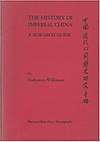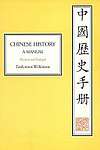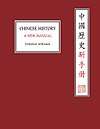Chinese History: A New Manual
 | |
| Author | Endymion Porter Wilkinson |
|---|---|
| Country | United States |
| Language | English |
| Publisher | Endymion Wilkinson |
Publication date | 2018 |
| Media type | |
| ISBN | 978-0-9988883-0-9 |
| Preceded by | Preliminary edition: The History of Imperial China: A Research Guide (1973); 1st edition: Chinese History: A Manual (1998); 2nd edition: Chinese History: A Manual, Revised and enlarged (2000); 3rd edition: Chinese History: A New Manual (2012); 4th edition (2015) |
Chinese History: A New Manual (Chinese: 中國歷史新手册; pinyin: Zhōngguó lìshǐ xīn shǒucè), written by Endymion Wilkinson, is an encyclopedic guide to Sinology and Chinese history. The New Manual lists and describes published, excavated, artifactual, and archival sources from pre-history to the twenty-first century, as well as selected up-to-date scholarship in Chinese, Japanese, and Western languages. Detailed annotations evaluate reference and research tools and outline the 25 ancillary disciplines required for the study of Chinese history. Introductions to each of the 76 chapters and interspersed short essays give encyclopedic and often witty summaries of major topics for specialists and general readers, as well as directives on the uses of history and avoidance of error in thought and analysis. The New Manual received the Prix Stanislas Julien for 2014.[1]





Since its first appearance in a preliminary version in 1973, Wilkinson’s manual has been continuously in print (selling on average 700 copies a year). During this time it has grown from 70,000 words to its current size of 1,302 pages and over 1.6 million words (the equivalent of twelve monographs of 400 pages apiece).
The author has kept it up to date by issuing numerous revised editions, each enlarging its scope. But perhaps a more fundamental reason for its continued success (to judge from readers’ comments on Amazon.com) is that the manual has established itself as more than an exercise in Quellenkritik (source criticism) by posing original questions and summarizing issues.
Background
In an interview with Carla Nappi, an historian of China at the University of British Columbia, Wilkinson discussed his experience in the field and the book's background. He became interested in China as an undergraduate at Cambridge University in the early 1960s, then spent two years teaching English in Beijing up to the outbreak of the Cultural Revolution. He earned a PhD from Princeton University with a dissertation on late Qing dynasty markets and prices, but when he began teaching he still felt unprepared. He did not know, he recalled, what to tell his graduate students about the Zhou or Shang dynasties, about which he felt his knowledge would hardly "fill an eye bath." On a research fellowship at Harvard University, Wilkinson mentioned to John Fairbank, a senior Harvard scholar, that he was gathering notes on Chinese history. Fairbank offered to publish them, and the 1973 Research Guide appeared in due course.[2]
Wilkinson served in Beijing as the European Union Ambassador to China from 1994 to 2001, and in his spare moments turned the 1973 Research Guide into the first and second editions of the manual. After he retired from the EU in 2001, Harvard invited him to teach Chinese history, including a graduate seminar on sinological methods. From then on he worked on the New Manual, commuting between Harvard and Peking University (where he was a visiting professor). In this way he was able to make full use of the Harvard-Yenching Library as well as all the scholarly resources that Beijing has to offer.[2]
The preliminary version of the manual (1973) was published by Harvard's East Asia Research Center. From 1998 until 2015 all editions were published by the Harvard University Asia Center for the Harvard-Yenching Institute and distributed by Harvard University Press. The fourth edition was also published in Chinese and sold 11,500 copies in the first year (2016-2017). Starting with the Fifth edition (2018), Wilkinson decided as an experiment in lowering the sales price of the English edition to publish it himself and distribute it exclusively on Amazon. The fifth edition was also published digitally (on the Pleco platform, in November 2017).
The Fifth edition (2018)

The author explains in the Preface the principal aims of the Fifth edition as being to introduce:
1. The different types of transmitted, excavated, archival, artifactual, and ecofactual primary sources from prehistory to 1949 (and in some cases to the present). Accordingly, it examines the context in which these sources were produced, preserved, and received, as well as the problems of research and interpretation associated with them;
2. The ancillary disciplines required for the study of Chinese history from prehistory to 1949 (and in many cases up to the present), including archeology, astronomy, bibliography, chronology and calendrics, codicology, diplomatics, epigraphy, genealogy, historical geography, historical linguistics, numismatics, onomastics, paleography, prosopography, sigillography, statistics, textual criticism, topography, transcription, translation strategies, and special branches of study such as oracle-bone script, bamboo and silk books, Dunhuang, Qingshuijiang, and Huizhou documents or the Ming-Qing archives;
3. The key secondary sources on questions of current focus and controversy in Chinese historical studies;
4. The latest electronic resources to disseminate, sort, and analyze Chinese historical data.
In addition to the four principal aims, the Fifth edition also has five subsidiary objectives (5–9), the ninth of which has not featured in previously editions:
5. To provide a sense of change over time and therefore to avoid anachronistic, ahistorical interpretations of China’s past. This is easily done because the scope of the New Manual is the whole sweep of Chinese recorded history, in the course of which long-term changes are readily apparent.
6. To supply readers who are familiar with one period a springboard into others with which they are less familiar.
7. To profile the strengths and weaknesses of Chinese historiographical traditions because (i) of the central role that the writing of history played (and continues to play) in Chinese politics and culture and (ii) to a greater extent than is commonly realized, historians rely on works produced in the old historiographical traditions, even though they may ask different questions and use different conceptual frameworks.
8. To provide English translations of key Chinese terms.
9. To illustrate the instinct of Chinese publishers to censor anything they think might contradict the official Party line on Chinese history. This is achieved by underlining in green some 30 or so examples of censorship in the Chinese translation of the manual published in 2016.[3] Most of the censored passages (and no attempt was made to show them all) are in one of four categories: (i) anything that might indicate that top CCP leaders are less than infallibly correct at all times. For example, in a discussion of political slogans Wilkinson mentions that during a meeting with Li Xiannian in 1979, the Vice Premier underlined the importance of the Four Modernizations but was unable to recall more than the first three (page 302). The paragraphs recounting this episode have been erased. Equally unacceptable to the censor were comparisons of CCP-era practices with rituals and procedures characteristic of imperial China. For example, in a discussion of flattering imperial honorific titles (zunhao 尊號) bestowed upon China’s emperors during their lifetimes, the author remarked that “zunhao” (in scare quotes) reappeared with the personality cult of Mao Zedong at the start of the Cultural Revolution (his was 20 characters long: 伟大的导师, 伟大的领袖, 伟大的统帅, 伟大的舵手(Great Teacher, Great Leader, Great Commander, Great Helmsman). The paragraph was scrubbed (page 288); (2) anything touching border issues even if this meant deleting a passage from a historical source that contradicts the current CCP line while retaining a passage from the same source that supports it (page 203). Even the author's correct observation that the History of the Ming (1745), the official history of the dynasty, places Taiwan in the section reserved for foreign countries was deleted (page 953); (3) anything showing Chinese people making fun of propaganda slogans (page 302); (4) any statistical estimate that differs from official statistics on sensitive issues was simply suppressed. For example, the number of people who died of starvation during the Great Chinese Famine (page 542).[4]
Content & Structure
The Fifth edition updates, expands, and corrects the fourth edition (2015). Some 12,000 primary and secondary sources, reference works, journals, book chapters, journal articles, and 246 databases are introduced in the course of the discussion (compared to 9,800 in the fourth edition; 8,800 in the third edition; 4,000 in the second edition (2000); and 2,900 in the first edition (1998). Of the 12,000 resources roughly one-third are primary sources (almost all Chinese) and two-thirds secondary sources (mainly monographs in Chinese and English, about equally divided between the two, and over 800 works in Japanese and other languages). Roughly 1,500 scholarly articles and book chapters are cited (mostly in English but also in Chinese, Japanese and other languages). A few hundred book reviews that make a substantial contribution are noted.[5]
Even while updating the content and presentation of the Fifth edition Wilkinson thought it wise to facilitate navigation (for readers of previous editions) by maintaining the basic structure of the manual which as before comprises 14 book-length parts subdivided into a total of 76 chapters. In other words, it is a case of new wine in old bottles. Books 1–9 present the sources by subject: (1) Language; (2) People; (3) Geography and the Environment; (4) Governing and Educating; (5) Ideas and Beliefs, Literature, and the Fine Arts; (6) Agriculture, Food, and Drink; (7) Technology and Science; (8) Trade; and (9) Historiography. Books 10–12 present pre-history and the sources chronologically by dynasty or group of dynasties (sources for the first half of the twentieth century are in book 13). Book 14 is on the history of the book in China and historical bibliography.[6]
Boxes & Tables
The main text of the manual is interspersed with 125 boxes (each providing further details on specific topics) and 152 tables (mainly consisting of lists or statistical data). Boxed topics range from guanhua jokes to the influence of images of the Buddha on the depiction of Confucius; from the board game Struggling to advance in officialdom to the speed of Chinese armies and fleets; from the connections between height and power to marching in step; from tomes in tombs to tomb robbers; from why women would have spoken with much thicker dialect accents than their brothers, to an analysis of duplicate biographies in the Histories. One series of boxes takes on the origins, history, and nature of Chinese characters. Another series gives a rundown on social history, such as coming of age and age at death. The tables include obvious data such as the dynasties of China, Japan, Korea, and Vietnam or the contents of major sources or reference works but also less obvious subjects from statistical analyses of the gender breakdown in the first four Histories or the amount of repetition in the Siku Quanshu to tables of extremely large and extremely small numbers; from ancient zodiacs to phases of the moon; from nautical units of measure to details of promulgated and actual weights and measures in different periods; from changes in book classification schemes (Han dynasty to the present) to changes in personal naming systems from the Zhou dynasty to the present; from the lexical influence of textiles to the size of steppe armies.
Changes in Typography
Overall the changes to the Fifth edition were so extensive (amounting to 130 pages of new material) that the manual had to be redesigned. The decision was made easier because one of the criticisms (especially from older readers) was that the light-weight typefaces used in previous English editions were difficult to read. Accordingly, three changes were made to the design of the Fifth edition: (1) light-weight fonts have been replaced with regular-weight fonts; (2) the main text is distinguished from bibliographic entries by using a serif font for the former and a non-serif for the latter; and (3) highlighting has been introduced: for example, boxes, are shaded in legal-pad yellow; tables in pale blue; and examples of passages censored in the Chinese translation of the manual are underlined in green.
Reception
Fifth edition: "Updated throughout with more than 100 pages of new material and reset in easily readable fonts, the Fifth Edition of Wilkinson’s Manual is the indispensable guide for Sinologists of all stripes. A monumental achievement!" Victor H. Mair (Professor of Chinese Language and Literature, University of Pennsylvania) quoted on the back cover of the Fifth edition (2018).
"A magnificent achievement; the most valuable English-language reference book on China anywhere." Richard H. Smith (Professor Emeritus of History, Rice University) quoted on the back cover of the Fifth edition (2018)
Fourth edition: "For any student of China (and at every level), Chinese History: A New Manual is not only a masterful scholarly endeavor, it is also (happily) a real page turner indeed, with captivating insights on every page."[7]
Third edition: Professor Nappi judged the New Manual (2012), “in every way, absolutely indispensable to work in Chinese history”[2] and journalist and China scholar, Jonathan Mirsky reviewing it in the New York Review of Books judged it to be "A mighty book...magnificent."[8]
References and further reading
- Mirsky, Jonathan (2013). "Chinese History a New Manual". NYR Blog. Also at China File December 10, 2013 link
- Davis, Chris, (2013) History manual takes scholarship to new level China Daily.com December 13, 2013.
- Sivin, Nathan (1975). "Book Review: The History of Imperial China: A Research Guide". Journal of Asian Studies. 34 (3): 821–824. doi:10.2307/2052561.
- Wilkinson, Endymion (2018). Chinese History: A New Manual, 5th edition. Cambridge, MA: Endymion Wilkinson distributed by Amazon.com. ISBN 9780998888309. The fifth edition is also available as an e-book on the Pleco platform.
- —— (2015). Chinese History: A New Manual, 4th edition. Cambridge, MA: Harvard University Asia Center distributed by Harvard University Press. ISBN 9780674088467.
- —— (2012). Chinese History: A New Manual. Cambridge, MA: Harvard University Asia Center distributed by Harvard University Press. ISBN 9780674067158. 2nd printing (revised), March 2013; 3rd printing (revised), September 2013.
- —— (2000). Chinese History: A Manual (Revised and Enlarged). Cambridge, MA: Harvard University Asia Center distributed by Harvard University Press. ISBN 0674002490.
- —— (1998). Chinese History: A New Manual. Cambridge, MA: Harvard University Asia Center distributed by Harvard University Press. ISBN 0674123786.
- —— (1973). The History of Imperial China; a Research Guide. Cambridge, MA: East Asian Research Center, Harvard University; distributed by Harvard University Press. ISBN 0674396804. Reprinted with corrections, 1974; reprinted 1975, 1990, 1992.
Notes
- ↑ The Stanislas Julien prize has been awarded annually by the French Académie des Inscriptions et Belles-Lettres (founded Paris, 1663) in recognition of outstanding scholarship on Asian culture. In all 120 people and two institutions have received the prize since it was inaugurated in 1875.
- 1 2 3 Carla Nappi, New Books in East Asian Studies University of British Columbia, March 8, 2013,
- ↑ The Chinese-language edition was published by Peking University Press in a boxed set of three volumes under the title Zhōngguó lìshǐ yánjiū shǒucè 中國歷史研究手册 and widely reviewed, for example by Shàn Yǐngwén 单颖文 who wrote a long profile of the author and the book in Wenhui Xueren 文汇学人 (Wenhuibao 文汇报), Shanghai, 2017/3/10, pp. 2-8;http://wenhui.news365.com.cn/html/2017-03/10/content_532662.html
- ↑ Wilkinson (2018), p. xv-xvi.
- ↑ Wilkinson (2018), p. xv.
- ↑ Wilkinson (2018), p. xvi.
- ↑ Eric Croddy, Amazon.com access date = August 8, 2015
- ↑ Mirsky (2013).